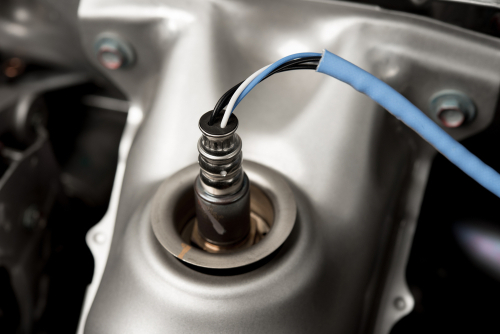Ever been cruising down the highway, enjoying the open road, when suddenly that pesky Check Engine Light ruins your day?
Well, buckle up, because we’re about to dive into one of those head-scratching codes: P0038.
This little troublemaker stands for “HO2S Heater Control Circuit High (Bank 1, Sensor 2).” Sounds like a mouthful, right? Don’t worry, we’ll break it down for you.

When your car throws a P0038 code, it’s telling you there’s an issue with the oxygen sensor heater circuit on Bank 1, Sensor 2.
This sensor plays a crucial role in keeping your engine running smoothly and efficiently. It’s like the health monitor for your exhaust system, making sure everything’s working as it should.
Now, you might be wondering, “Why should I care about this?”
Well, ignoring this diagnostic trouble code could lead to poor fuel economy, reduced performance, and even damage to your catalytic converter.
And trust me, that’s one repair bill you don’t want to see.
So let’s roll up our sleeves and get to the bottom of this P0038 business.
Key Takeaways
- P0038 indicates a problem with the oxygen sensor heater circuit
- Ignoring this code can lead to decreased fuel efficiency and engine performance
- Addressing P0038 promptly can prevent more costly repairs down the road
Understanding the Code P0038
The P0038 code indicates a problem with your vehicle’s oxygen sensor system. This pesky little trouble code can leave you scratching your head, but don’t worry – we’ll break it down for you.
What Is an HO2S?
HO2S stands for Heated Oxygen Sensor. It’s a crucial component in your car’s emissions control system. Think of it as a tiny detective, sniffing out the oxygen levels in your exhaust.
The “heated” part is important. These sensors need to be hot to work properly, kind of like how you need coffee to function in the morning. The heater element brings the sensor up to operating temperature quickly.
When the PCM detects a high voltage in the heater control circuit, it throws a fit and lights up your check engine light. It’s like your car is saying, “Hey, something’s not right here!”
Locating the Culprit: Bank 1 Sensor 2
Now, let’s decode the “Bank 1 Sensor 2” part of P0038.
Bank 1 refers to the side of the engine that houses cylinder number one. It’s like the VIP section of your engine block.
Sensor 2 is typically located after the catalytic converter. It’s keeping an eye on how well your cat is doing its job. Think of it as the quality control inspector of your exhaust system.
This specific sensor’s location is important because it helps pinpoint where the problem might be.
It’s like having a GPS for your car’s issues. When troubleshooting, you’ll know exactly where to look first.
Trouble in the Circuit

When your oxygen sensor’s heater circuit goes haywire, it’s like your car’s trying to cook breakfast without turning on the stove.
Let’s dive into the electrical shenanigans that can leave your engine management system scratching its head.
High Voltage Issues
You might think high voltage sounds cool, but trust me, your oxygen sensor doesn’t agree.
When the voltage in the heater control circuit spikes, your poor sensor can’t do its job properly.
This can happen if your wiring harness decides to play dress-up as a frayed rope. Check those connections, folks! A loose wire or a corroded connector can turn your precise sensor system into a game of electrical roulette.
Got a multimeter? Time to put it to work!
Test the resistance in your sensor’s heater circuit. If it’s reading higher than your mechanic’s hourly rate, you’ve got trouble.
Short and Ground Circuit Troubles
Now, let’s talk about shorts – and no, not the kind you wear to the beach.
A short circuit in your O2 sensor’s wiring can make your PCM think it’s dealing with a high voltage situation.
Ground circuit issues are like bad plumbing – they’ll mess up everything downstream.
If your sensor’s ground connection is flakier than grandma’s pie crust, you’re in for a world of electrical hurt.
Don’t forget to check your fuses! A blown fuse might be the silent culprit behind your P0038 code. It’s like trying to watch TV with the power off – ain’t gonna happen.
Remember, troubleshooting electrical issues can be trickier than a game of Twister. If you’re not comfortable poking around your car’s wiring, it might be time to call in the pros.
Implications of DTC P0038

When your car throws the P0038 code, it’s like your engine’s trying to tell you something’s not quite right with its oxygen sensor heater. This little hiccup can lead to some pretty significant issues if left unchecked.
Performance Hits
You might notice your ride’s not as peppy as it used to be.
That’s because a faulty oxygen sensor can’t properly gauge the fuel mixture, leading to some engine performance issues. Your car might start acting like it’s had one too many at the gas station.
You could experience:
- Rough idling (it’s not you, it’s the car)
- Hesitation during acceleration (0 to 60? More like 0 to “eventually”)
- Stalling (perfect for those awkward traffic light moments)
Your fuel efficiency might take a nosedive too. Suddenly, you’re visiting the pump more often than your favorite coffee shop.
Emissions Quandary
Here’s where things get a bit stinky – literally.
A malfunctioning oxygen sensor can lead to an emissions control nightmare. Your car might start pumping out more pollutants than a factory on overtime.
You could face:
- Failed emissions tests (bye-bye, clean air sticker)
- Increased harmful emissions (Mother Nature won’t be sending you a thank-you card)
- Potential legal issues (depending on your local regulations)
The Diagnostic Process
Diagnosing a P0038 code requires a methodical approach and the right tools. You’ll need to put on your detective hat and follow a step-by-step process to pinpoint the issue.
Navigating the Diagnostic Steps
First things first, you’ll want to connect an OBD-II scanner to your vehicle.
This nifty device will help you confirm the P0038 code and check for any other related codes that might be lurking.
Next up, give your car a good once-over. Look for obvious signs of trouble like damaged wiring or loose connections. You’d be surprised how often a simple visual inspection can save you hours of head-scratching!
If nothing jumps out at you, it’s time to dig deeper.
You’ll need to test the oxygen sensor’s heater circuit. This might sound daunting, but don’t worry – we’ll walk you through it.
Finally, check the Engine Control Module (ECM) for any software updates. Sometimes, a simple update can fix quirky sensor behavior.
Tools of the Trade
To tackle this diagnostic adventure, you’ll need a few trusty sidekicks in your toolbox:
- OBD2 scanner: Your first line of defense against cryptic engine codes.
- Multimeter: This gadget will help you test circuits and voltages.
- Wiring diagram: Think of it as your treasure map to the car’s electrical system.
- Patience: Not a physical tool, but trust me, you’ll need it!
Don’t forget about your vehicle’s repair manual. It’s packed with specific information about your car’s systems and can be a real lifesaver.
Vehicles Under the Scanner
You might be surprised to learn which vehicles are prone to triggering the P0038 code. Let’s take a look at some common culprits and their quirky habits when it comes to oxygen sensor hiccups.
Make-Specific Scenarios
Dodge and Chrysler vehicles, especially those from the early 2000s, seem to have a knack for flashing this code. You’ll often find your Dodge Ram playing tricks with its oxygen sensors.
Toyota and Lexus owners, don’t feel left out! Your rides can join the P0038 party too, particularly in models with higher mileage. It’s like these cars are trying to prove they’re still young at heart.
Nissan and Infiniti vehicles have been known to throw this code, often accompanied by a slight dip in fuel economy. It’s their way of saying, “Hey, pay attention to me!”
You Audi drivers might experience this more in older models. It’s as if these German engineering marvels are testing your problem-solving skills.
Chevrolet, Ford, and Hyundai aren’t immune either. Your trusty American and Korean steeds can sometimes decide to spice things up with a P0038 code.
Frequently Asked Questions
What steps can I take to resolve a P0038 error code in my vehicle?
First things first, check those wires!
The P0038 code often pops up due to damaged or corroded wiring.
Give them a good once-over and replace any suspicious-looking bits.
Next, take a look at your oxygen sensor. If it’s seen better days, it might be time for a replacement.
Remember, a happy O2 sensor means a happy engine!
What are the typical symptoms indicating a P0038 error might be at fault?
You might notice your engine running a bit rough, like it’s had one too many at the local watering hole.
Poor fuel economy is another red flag – if you’re suddenly best buddies with the gas station attendant, something’s up.
Oh, and that pesky Check Engine light? Yeah, it’ll probably be giving you the stink eye from your dashboard.
Can you guide me through the process of diagnosing a heater control circuit malfunction for bank 1 sensor 2?
Sure thing, partner!
First, grab your trusty multimeter. You’ll want to check the voltage at the sensor’s connector when the engine’s running.
If it’s higher than specs, you’ve found your culprit.
Next, inspect the wiring between the sensor and the PCM.
Look for any signs of damage or corrosion. Sometimes, a little electrical tape can save you a big headache!
What specific issues have Jeep owners encountered related to the P0038 code?
Jeep owners, you’re not alone in this rodeo.
Many of you have reported issues with faulty O2 sensors triggering the P0038 code. It seems these sensors love to go on vacation without warning.
Some Jeep models also tend to have wiring harness problems.
Check for any chafing or exposed wires, especially near hot exhaust components.
For Dodge vehicles, how does the P0038 code typically manifest, and what fixes are available?
Dodge owners, listen up!
Your P0038 troubles often stem from corroded connectors or damaged wiring. Give those connections a good cleaning and see if that does the trick.
If that doesn’t work, you might be looking at a faulty oxygen sensor. Luckily, replacing it isn’t too tough.
Just make sure you get the right one for your model!
How do I locate the HO2S bank 1 sensor 2 in my vehicle?
Time for a little hide and seek! Your HO2S bank 1 sensor 2 is usually hanging out downstream of the catalytic converter on the passenger side of the vehicle.
Look for a sensor with wires coming out of it, nestled snugly in the exhaust pipe.
Just be careful – that exhaust can be hotter than a jalapeño in a heat wave!
